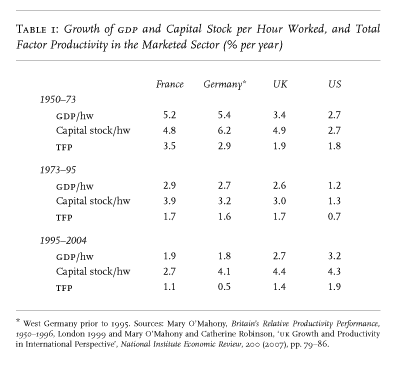The scope of Robert Brenner’s The Economics of Global Turbulence is vast. It proposes both a description of, and a theory to explain, the macroeconomic performance of the advanced capitalist economies from 1945 to 2005, focusing around close studies of the top three—the us, Germany and Japan. No other single work has attempted anything comparable in combined breadth of field and duration of coverage: both the ‘golden age’ and what Brenner terms ‘the long downturn’, running from the early 1970s to the present day. A number of significant studies have examined the post-war world economy up to the 1980s, among them Stephen Marglin and Juliet Schor’s The Golden Age of Capitalism and Hermann Van Der Wee’s Prosperity and Upheaval: World Economy, 1945–80; while Jeffrey Frieden’s Global Capitalism offers comparisons between the current era and the 1930s, but does not provide a historical narrative as such. The majority of economic historians, it seems, prefer to operate under the 30-year rule: although much interesting work is now being done on the 1960s and 70s, after the 1980s we are largely in limbo. Barry Eichengreen’s The European Economy Since 1945 is one of the few analyses that does cover the whole period, but its geographical scope is much narrower than Brenner’s.footnote1
Recent work by world-economic historians, by contrast, has tended to focus on the very long run: the institutions necessary for economic growth—Douglass North’s work on property rights, Daron Acemoglu’s on dictatorship and democracy, Avner Greif’s study of Maghrebi trader networks and informal social structures, for example—or the origins of capitalism and the ‘great divergence’ between the West and the rest in the modern era; the latter two both fields to which Brenner has also contributed. As regards contemporary capitalist development, however, perhaps—taken as a pair—the two books by the late Andrew Glyn, his earlier Capitalism Since 1945 and his final work, Capitalism Unleashed, published in 2006, offer the closest comparator to The Economics of Global Turbulence; though Glyn was never as grindingly pessimistic as Brenner on the overall outlook for the advanced capitalist economies.footnote2
This salience makes it all the more important to subject Global Turbulence to serious critical scrutiny. To make my task manageable, I will confine my comments to the period that Brenner labels ‘the long downturn’ which began, he suggests, at the end of the postwar Golden Age in 1973 and is still with us today. This is described as ‘an era of slower growth and increasing economic turbulence . . . marked by deeper recessions and the return of devastating financial crises absent since the Great Depression’.footnote3 By narrowing my focus in this way, I can address in detail the aspects of the book that strike me as the most contentious and where an assessment first made in 1998 seems in need of more revision than Brenner concedes.
Brenner makes three main claims which I wish to examine with regard to the experience of Europe and, especially, the United States. First, he describes the economic performance of the advanced countries as worsening over each business cycle during the long downturn in terms of the growth of output, productivity, capital stock and real wages. Second, he argues that the rate of profit, especially in manufacturing, is the fundamental determinant of an economy’s growth performance and that adverse trends in profitability are the root cause of the long downturn. Third, he rejects the suggestion that trends in productivity, driven by the pace of technological progress and success in catch-up growth, can be seen as the main drivers of the growth process.footnote4
I wish to raise three questions. Is the description of economic performance accurate? What explains the chronology of productivity growth? And does the rate of profitability in manufacturing really matter so much?
Brenner’s description of developments in the advanced capitalist economies since 1973 is remorselessly pessimistic. The title of his book sets the tone with the phrase ‘global turbulence’. The reader of this book would hardly guess that the literature of macroeconomics has labelled the period since the 1980s the ‘Great Moderation’ in respect of its exceptionally low volatility of gdp in a low-inflationary era.footnote5 Whether this is the result of better policy, changes in the structure of oecd economies or simply good luck in the absence of nasty exogenous shocks is not clear but this has not stopped politicians such as Gordon Brown, the British Chancellor of the Exchequer from 1997 to 2007, claiming the credit for ending boom and bust and presiding over an unprecedented period with no quarter of negative gdp growth.
Clearly, there was a big growth slowdown after 1973. Growth of real gdp per person in the countries of western Europe averaged 4.06 per cent per year in the years 1950–73, but only 1.86 per cent from 1973 to 2005, while for the United States growth in these two periods was, respectively, 2.45 per cent per year and 1.91 per cent.footnote6
